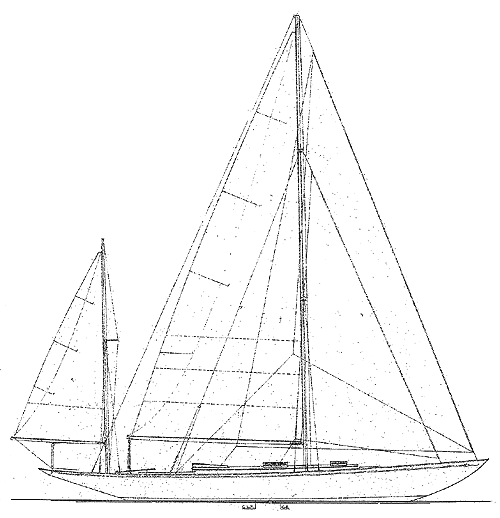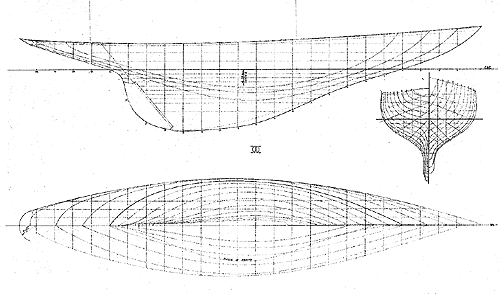 |
|
|
| THE CLASSIC YACHT |
| Towards an interpretation |
| David Ryder-Turner, Scotland |
There are probably no words more hackneyed and misused in the lexicography of yachting than ‘classic’ and ‘classical’. They are used indiscriminately by writers who cannot find the appropriate adjective that is more descriptive or accurate – particularly if they are seeking some redeeming feature in an otherwise undistinguished design. There is an English-speaking magazine that incorporates one of these words in its title, but, whilst having many excellent examples of what we think of as a ‘classic’ includes craft with little claim to being so designated, other than being built of wood, having a gaff rig, and probably of work-boat antecedants. That they may be poor examples of the type, inappropriate for their intended use matters not – they are ‘classic’. Not that there is anything ‘wrong’ – quite the reverse – in being a wooden boat, or having a gaff rig, or derived from work-boat origins. What is wrong is to take an example that is poorly designed, and/or poorly-constructed, and, simply on the basis that it has some or all of the aforementioned criteria, label it a ‘classic’. This same criticism applies equally to boats of a more modern configuration where the standards that are implied in the words ‘classic’ or ‘classical’ are absent. A more appropriate word, in many cases, is ‘traditional’; that is “has prevailed or been accepted from generation to generation” (Oxford Dictionary). In other words, “That’s the way it was, has always been, and therefore must be right”. Wrong. Too many ‘design’ features and practices have been perpetuated because they are old and have become venerated, when a more perceptive examination of the design or practice would show that it is either inappropriate, or inadequate (or both) to the function that it is now called upon to fulfill. Furthermore, the design or practice was, probably, initially adopted in the absence of better knowledge, skills, or materials. So – what do we, or should we mean by the terms ‘classic’ or ‘classical’? Websters Dictionary devotes one whole column of closely-spaced type to the words and their variants and derivations. Given that there are so many it is not surprising that they are misused through lack of precision in the minds of the writers. The words themselves do not, of course, have an application solely to the field of watercraft; they are universal. So it is interesting to compare our usage with that of other creative arts (for, surely, the design and construction of such a fine creature as a yacht should be deemed an art, even though science and technology have their proper place in the creation thereof?). Music, Fine Art, Architecture; each has its own vocabulary, and the terms ‘classic’ and ‘classical’ feature prominently. ‘Classical’ has chronological implications, and the products of these particular periods are deemed ‘classical’. If we speak of ‘Classical Architecture’ we convey the idea or visual impression of Greek and Roman buildings, with their distinctive structures – Doric, Ionic, Corinthian colums; pediments and platforms with their optical corrections by entasis. ‘Classical’ music more specifically refers to that period which is exemplified by the works of Haydn, Mozart & Beethoven, and their contemporaries or near-contemporaries. In both instances the works are characterised by distinctive structures and they have an enduring elegance and appeal. And in neither instance would the composers or architects/builders have regarded their works as ‘classical’. It is posterity that accords that mark of distinction, and it does so with the advantage of hindsight and the ability to compare and contrast with what preceeded or was subsequent to the work in question. It is this ability to make such comparisons that makes it possible to form objective assessments as to fitness for purpose and quality. Is there a ‘classical’ period in yacht architecture and construction? Taking a deep breath I jump in at the deep end and hopefully you’ll allow me to come up still breathing! As far as yachts are concerned, I think we can define the beginning of the ‘Classical’ period as being that when craft were being designed and built specifically for pleasure sailing, rather than being adaptations of workboats. This is not to say that workboats cannot be adapted for ‘yachting’ per se; many pilot cutters, life-saving vessels, and even fishing boats, have been converted successfully, but in many (most?) cases alterations of a greater or lesser extent have had to be made in order to accommodate the vessel to its new role. The yacht and the workboat, whilst having many features in common and both being subject to the same ‘laws’ of hydro-dynamics have a different start-point. Of course, the experience and lessons to be gained from workboats will flow over into yacht design, but since the function is different then the resolutions will be different too. So, the beginnings of ‘classicism’ in yacht architecture can be said to show up in the first half of the 19th century, when competitive (and often weathly) owners had craft specifically designed and built in order to achieve precedence over their contemporaries. In his excellent book “The Northseaman”, John Leather illustrates these developments in his studies of the East Coast of England boatbuilders – men such as Harvey and Aldous, and Michael Ratsey of Cowes on the Isle of Wight. The design and construction of yachts – and in these early days of the Classical Age of Yachting they were mainly for racing purposes – called for refinements in shape and building methods and materials. In the subsequent 100 years the art and science of yacht building became a specialized aspect of naval architecture, and the products were, and are, sophisticated creations. The spur to this striving after excellence was Racing. As each successive Rule sought to block the development of what were considered to be undesirable features of design or construction, so did the designers seek out loopholes and means to circumvent the restrictions. Whilst many unwholesome, and as we would see it now, plainly unseaworthy craft were produced, nevertheless there was a positive advance in all aspects of yacht architecture towards what were – and still should be – regarded as the Verities - Beauty, Habitability, and Speed. It would be fair to say that no two persons will have exactly coincident ideas and definitions on each of these desiradata; but it is probably fair to say that there will be a degree of unanimity as to whether or not a yacht is beautiful or otherwise. It is a matter of scale and proportions, of lines and the interplay of lines and planes – that almost indefineable quality of ‘eye-sweetness’. Thus it is that a sheerline drawn by Fife, or Rasmussen, or Gardner, will stand out in a crowded anchorage, and draw the eye to that boat, by-passing others of lesser quality. The end of the ‘Classical’ period – if indeed we have come to the end – coincides, I believe, with the advent of G.R.P. construction. I do not consider that G.R.P. is, in itself, ‘bad’. It is a ‘new’ medium, requiring different techniques in design and construction. ‘One-off’ craft built in G.R.P. are more expensive than ‘one-off’ boats of wood, and for this reason (amongst others) G.R.P. is used in the multiple production of single designs. Furthermore, in order to be an economically sound enterprise, the quantity production of a particular design requires modern marketing techniques. Thus, the Sales Manager’s demands often over-ride the artistic and aesthetic desires of the Designer. As a result we got, and get, a plethora of craft that are characterized by fat quarters, excessive sheer height, fin and skeg configuration (because that is what offshore racers have, and racing rules and requirements spin off into cruising boats), and are often beasts to sail. There are good boats in the post-classical period, and they deserve to be called ‘Classics’ – I have the Contessa ‘32’s in mind; they have a refinement of line that marks them apart from the multitudes of … well, you know what I mean. Which brings us (at last, you will say) to consider what it is that qualifies a boat for that most elusive, yet so indiscriminately used, accolade – a ‘classic’? Quite honestly I don’t think it is possible to give an absolute definition of what we mean by the term ‘classic’. It is often a feeling that is engendered by the harmony and balance of all the lines, such that the sum of the parts confers upon the ‘whole’ a further dimension – quality. As in Music and Architecture, so too in yacht design it is the balance and harmony, the exactness and clarity of line, the perfection of the underlying structure that marks the quality product apart from lesser breeds. There will be imitations and copyists, and they will sometimes come close to the original, but the true ‘classic’ will stand out from the pseudo-classic, for all time. If we take the Oxford Dictionary definition of these two words, ‘classic’ and ‘quality’ I think we’ll come a bit closer to understanding what we mean when we use them to describe, say, a Fife or Rasmussen 12-metre, or a Reimers skerry-cruiser or the many products of past designers and builders that grace those gatherings at ‘Classic’ and ‘Veteran’ Regattas. Classic (adjective). “Of allowed excellence, often cited as a model of excellence; often referred to as a standard”. Classical (adjective) “In the simple, harmonious, proportioned, restrained style….” Quality (noun) “The degree of excellence, in terms of attributes, traits, faculties.” Now, if you put all these together I think we come some way towards defining what we mean by ‘the classic’ yacht! Just as posterity accords the term ‘classical’, so too is ‘classic’ an attribute which only posterity can assess. It requires the perspective that only time can give, for there is an element of comparision inherent in the term. Just as Ludwig van Beethoven would never have called his compositions ‘classic’, so neither should we have the temerity (or is it arrogance?) to accord such a distinction to our products. We should not think of either the Pompidou Centre, or Lloyds of London buildings as being ‘classics’ – some will say that, rather than being works of art, they are examples of the way in which science and technology have combined to produce monolithic structures that, far from being ‘classical’, are reflections of, and analagous to some of the worst examples of Modern Art! I’m not going to cite any particular yacht as being similarly analagous, but you only have to look in the glossy yachting magazines to see plenty of examples. Let me offer you a contrast, in examples of two designs recently drawn. In the earlier-mentioned magazine appeared the sailplan and profile of a craft that has all the characteristics of today’s ‘sports boats’; narrow bow and wide quarters; plumb stem and almost plumb stern; spade rudder (without skeg) and deep fin and bulb keel. The accompanying text proclaimed that this design was for ‘a fast daysailer that could combine the classic look and detailing of boats of the 1930’s with the higher performance and user-friendliness of today’s racers’. And to further add to the horror of sales-talk was the heading to the piece – ‘An Instant classic is born’! In contrast to that is the outline for a design produced this year for an American client. It is a 1930’s version of a yawl that was designed by William Fife in 1896 for the client’s great-grandfather, which you will see in Waldo Howland’s ‘A Life in Boats’ (2nd volume). The brief called for a cruising yawl in the style of Fife (or Rasmussen, or whoever) circa the middle of the 20th century. I cannot, and will not, claim that it is a classic (instant or otherwise), but I hope that posterity will recognise its ‘classical’ antecendants and inspiration. |
 |
 |
|
|
| zurück • Home |